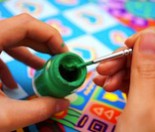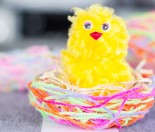When you start scrapbooking you will hear all sorts of terms and jargon, and it will feel like scrapbookers speak in another language. Don’t worry – after a few months working on your album, you’ll know every scrapbooking term around. This glossary will help you decipher the most common scrapbook jargon, so at least you’ll be able to understand others at your first crop night…..see jargon already.
12 x 12
12 x 12 refers to the standard size of scrapbooking pages and albums, and it is measured in inches. Some people prefer to work with 8” x 8” albums, and in the United States 8.5” x 11” (our A4) is also very popular.
Acid Free
Acid makes paper go weak and brittle, so it is important to use only acid free material in your scrapbook albums. When scrapbooking first started acid free paper and card was something special, but nowadays it is considered the norm. To make sure you are getting acid free paper, buy your supplies from a specialist scrapbook store.
Brads
Brads are like split pins which can be added to your page to give detail or decoration. They come in all sorts of shapes, sizes and colours, and are easily attached. Simply poke a hole in your page with a pin, poke the brad through, and push the legs back against the page.
Colour Fast
Colour fast is the term given to inks, papers and card which is fade resistant.
Corner Rounder
A corner rounder takes the square edge of a photograph or mat (see below), and gives it a rounded finish.
Cropping
Cropping is the term used to describe the trimming of photographs. People crop a photo to improve it in some way – for example trimming out unnecessary background. Cropping photographs means you can make a feature of the best parts, and get rid of the rest.
Crop Night
Crop nights, crops, or chat n scraps, are all names given to events where people get together to scrapbook.
Die Cut
Die cuts are shapes which have been machine punched out of card or paper, using a die pattern. You can buy die cut decorations in packets, or you can buy die cut machines and punches to use at home. The most common brand of home die cutting machines in New Zealand is Sizzex.
Embellishments
The term ‘embellishments’ covers anything that is used to decorate a page. Common embellishments include brads, fibre, stickers, die cuts, eyelets, ribbons and buttons, but the list is literally endless with new embellishments being designed everyday.
Eyelets
Eyelets are like rivets and are used both for decoration and functional purposes. When eyelets are set in your page, they look similar to shoelace holes in a shoe. You can use them to secure pages together, attach other embellishments, or use them as an embellishment on their own.
Heritage
Heritage is the term given to albums or layouts which involve old or historic photographs. A heritage album is something many people do as a gift for their parents or grandparents.
Journaling
Journaling is the details you write about the photos on your page. Traditional scrapbooking included a lot of journaling, as the whole point was to record memories such as dates, names, and occasions. Nowadays, journaling has become less important to some scrapbookers, and many don’t journal at all. How much journaling you do is a personal choice, but consider that you may not remember the details in years to come, if you haven’t written them down.
Lignin Free
Lignin is a substance found naturally in plant cells, and causes paper from wood pulp to go brown. Most acid free paper and card is also lignin free, but it pays to check.
LSS
LSS is an acronym for Local Scrapbooking Store and is often used on message boards and chat rooms about scrapbooking.
Mat
A mat is a piece of card which is cut slightly larger than your photograph. The photograph is then stuck to the mat, leaving a border of card around the edge. A double mat is when you stick the photograph to a mat, and then that mat to a bigger mat.
Memory or Keepsake Album
A memory or keepsake album is another name for a scrapbook.
Mount
To mount a photograph means to ‘stick’ or ‘adhere’ a photograph to the page.
Page Protector
A page protector is a polyproplene sleeve which your scrapbooking page slides into. Most albums are simply a series of page protectors secured together with a cover. Page protectors have either a top or side opening for your page to slip in.
Photo Corners
Photo corners are small triangle shaped pockets which stick to your page. The corners of your photograph then slide in the pocket, and the photo corners hold your picture in place. Nowadays, photo corners are mostly used for heritage albums.
Photo Safe
Photo safe is a relatively new term which suggests that the material, card, paper or embellishment is photo safe. While there is no regulations stating what photo safe actually means, it usually refers to things that are acid or lignin free.
Photo Splits
Photo splits come in rolls like double sided sellotape, but they pull off in 1cm tabs. You use photo splits on the back of your photograph to mount them in place.
Punches
Punches are tools which punch out decorative shapes which can be added to your page. There are literally hundreds of different shaped punches available, and you can make ‘punchies’ for just about every theme.
Punchies
Punchies are the shapes which are punched out from card, using a punch.
Punch Art
Punch art is a form of embellishing which uses punchies to make and create embellishments. This is sometimes referred to as paper piecing also.
Template
A template is like a stencil, and depending on the template, it can be used for all sorts of things. Shape templates are designed to help you crop photos in specific shapes. Page templates help you lay out a balanced page. To use a page template, simply cut photos and mats to the specified sizes, and lay them in the gaps.
Title
A title is the term given to what you name your page. Most scrapbook pages are given a title, and it usually included as a part of the layout.
Trimmer
A trimmer is like a guillotine which enables you to cut straight edges easily. The most popular trimmers have a backwards and forwards mechanism, rather than a blade that gets lifted up and down.
As you continue to scrapbook, you will come across plenty of other terms and jargon, and there are new phrases being developed everyday. Before you know it, you’ll be talking scrapbooking like you’ve been doing it for years.





